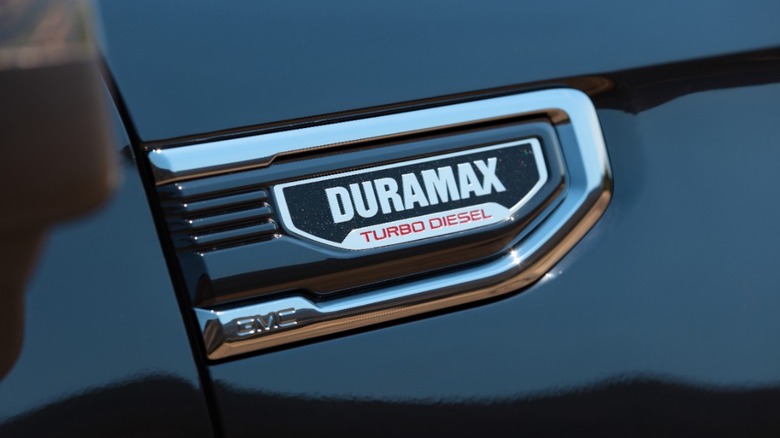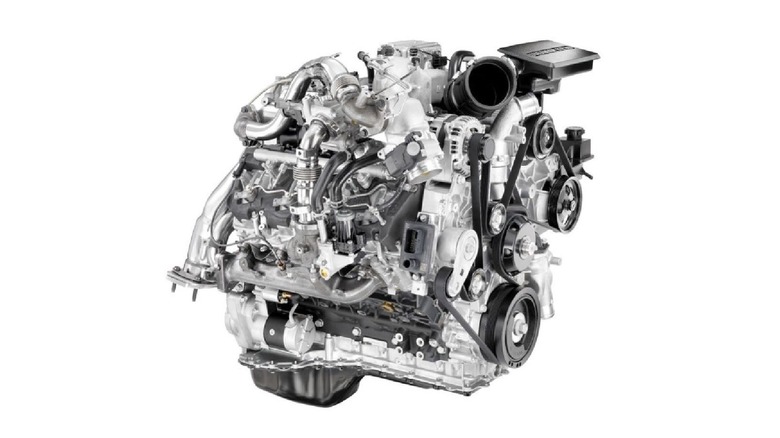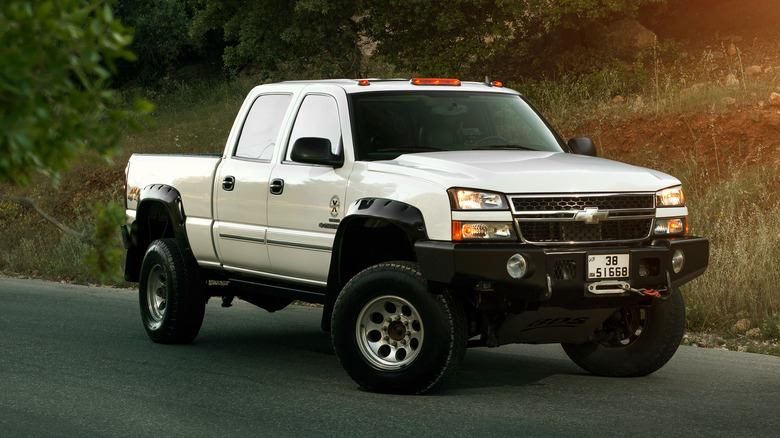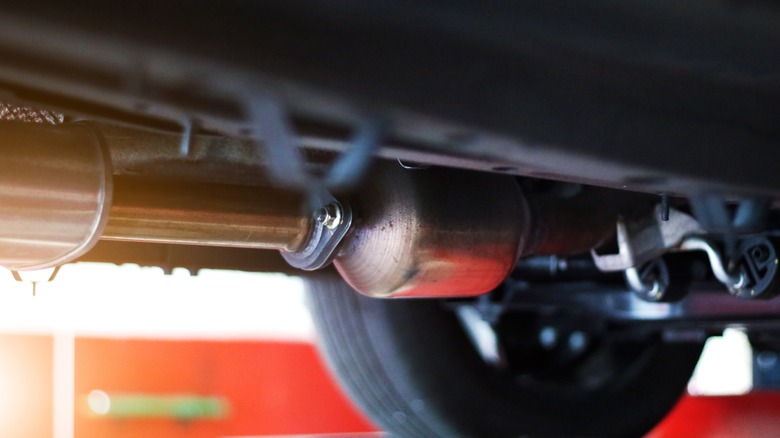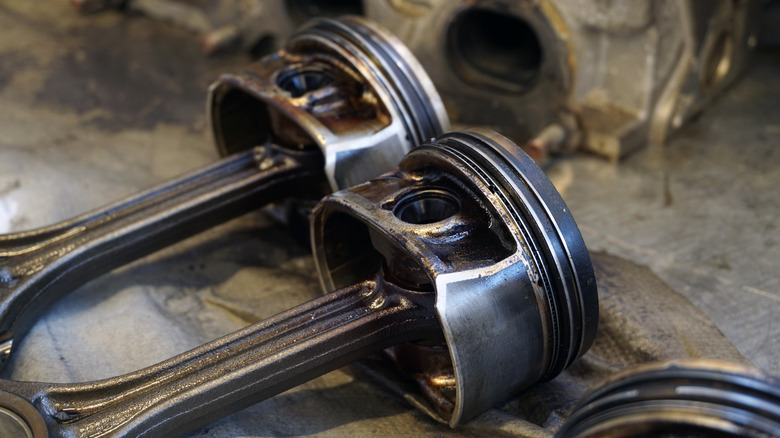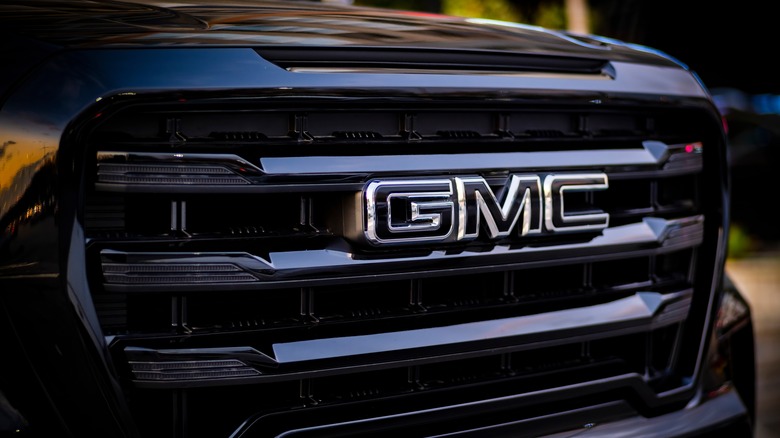Everything To Know About The GM 6.6 Liter LBZ V8 Duramax Turbo Diesel Engine
These days, the Duramax namesake is as linked with turbo diesel engines as peanut butter is to jelly. That wasn't always the case, though. In the late '80s and early '90s, GM's Detroit Diesel couldn't hold a candle to the rugged torque monsters in both the Cummins and PowerStroke turbo diesel lineups. It wasn't until 2001 that Dodge and Ford had a truly worthy opponent in the form of the GM LB7 Duramax.
Despite being the new kid on the block, GM came out swinging with the LB7. Despite its class-leading torque figures and impressive overall performance, the LB7 had its fair share of teething problems. With reliability being such a crucial aspect of turbo diesel work truck engines, injector problems and head gasket issues kept the Duramax in third place behind Cummins and PowerStroke offerings despite the Duramax's impressive performance. While the second LLY iteration of the Duramax was a step up, the third generation LBZ Duramax — released in 2006 — was the engine that put the Duramax ahead of the competition.
In many ways, the LBZ Duramax simply took GM's existing turbo diesel formula that they had been refining for five years and turned it up to 11. The LBZ was built on the foundation of the previous LLY generation Duramax but was improved to provide better reliability, more power, and improved efficiency. It remained a relatively simple engine, despite the changes, which made it a fan favorite amongst turbo diesel enthusiasts long after its production ended in 2007.
A big step up from the LLY
Despite resembling the 2004-2005 LLY generation Duramax in terms of its overall design and construction, the LBZ is a significantly improved engine. Strength was never really an issue for previous Duramax engines, but as horsepower and torque figures continued to climb, GM fortified the LBZ to better handle extreme forces. The engine block was fortified using a thicker casting with additional main bearing webbing and improved cylinder bore strength. GM also beefed up other crucial internals, including new and improved forged steel connecting rods.
The fuel system was another critical aspect of improvement, with the LBZ receiving multiple new fuel system components. While the common-rail fuel system and high-pressure fuel injectors were a source of issue for the older LLY engine, the system was overhauled for the LBZ. GM increased the maximum fuel pressure from 23,000 psi to over 26,000 psi and updated the Bosch fuel injectors to a more efficient 7-hole design.
GM also made some important revisions to the turbo arrangement to improve reliability and efficiency. The LBZ received revised low-compression pistons, which decreased the chances of engine-damaging detonation events and increased reliability overall. GM also revised the LBZ's turbo inlet manifold to a more free-flowing design, decreasing exhaust gas temperatures and delivering better turbo responsiveness. To tie it all together, GM introduced a new 32-bit E35 engine control module, which more effectively managed fuel flow and turbo parameters.
As a result of all of the upgrades compared to the previous generation LLY Duramax, the 2006 LBZ Duramax was the most reliable, efficient, and best-performing turbo diesel engine that GM created to that point.
The LBZ Duramax lived a very short life
Despite being one of the most popular turbo diesel engines in history, the LBZ Duramax is tied with the LLY generation for having the shortest production run in the engine series' history. The LBZ was only produced for the 2006 and 2007 model years, eventually being replaced with the similar — yet slightly less impressive — LMM Duramax engine in 2007.
The LBZ Duramax arrived on the scene at a very turbulent time for turbo diesel engines due to increasingly stringent emissions requirements. Since the LBZ lacked modern diesel emissions devices, it lived a very short life under the hoods of only a few GM vehicles.
In fact, the LBZ Duramax only found a home in 2006-2007 Chevrolet Silverado HDs and 2006-2007 GMC Sierra HDs, making them a relatively scarce engine in comparison to later entries in the Duramax engine family. With such a short production run, it is safe to assume that there are far fewer LBZ engines out there than the 600,000 LML Duramax engines produced between 2010 and 2016.
The last dirty diesel
Before 2006, diesel engines — including engines in the Duramax engine series — did use multiple pieces of equipment to reduce diesel emissions. For example, the earlier LLY Duramax was the first engine in the series that featured required emissions tech, including an exhaust gas recirculation system that sent exhaust gasses back into the combustion chamber to burn off additional pollutants. The LLY also featured an EGR cooler and a catalytic converter to limit diesel emissions to an acceptable degree.
However, in 2007, the U.S. government mandated that all fuel stations in the U.S. make the switch to Ultra Low Sulfur Diesel (ULSD) and required that any diesel vehicle manufactured after the 2007 model year must refuel only with ULSD fuel. Along with the rollout of ULSD came even more intense emissions equipment for diesel-powered vehicles, including diesel particulate filters (DPFs). Adding additional emissions equipment to any engine has a negative impact on performance, as it adds another restriction for exhaust gas to flow through before exiting the vehicle, especially when it gets clogged over years of driving.
The rollout of new emissions technology and Ultra Low Sulfur Diesel is the reason why the LBZ was replaced with the LMM engine in 2007 after only two years of production, as the LBZ lacked a DPF and other updated tech. However, that is the exact reason why most enthusiasts love the LBZ, as its lack of modern emissions equipment makes it a better engine to modify in addition to having a longer average engine life and achieving better fuel economy.
Piston problems
Despite being one of the most reliable engines in the Duramax engine family, the LBZ does have a couple of notable issues. Piston strength is one of the engine's major weak points. When the LBZ was designed with a lower compression ratio in mind, GM settled on a new cast aluminum design.
The newer piston design made use of thinner wrist pins and wrist pin bushings, which weren't used on earlier Duramax engines. While the revised design of the LBZ's rotating assembly mostly fixed the connecting rod issues that earlier LB7 and LLY engines suffered from, piston cracking became a major problem on the LBZ, especially on modified examples. The risk of cracking a piston on an LBZ becomes much higher around the 650 rwhp mark, as the high EGTs, advanced timing, and excessive heat near that power level significantly reduce the integrity of the pistons themselves.
So, it is a bit of a catch-22. While the LBZ is one of the easiest Duramax engines to squeeze massive amounts of power out of, it also has a catastrophic weakness in terms of its piston strength. For that reason, most professionals advise upgrading your LBZ pistons to a stronger aftermarket set if you intend on pushing beyond the 600-horsepower range.
The LBZ is the golden child of the Duramax lineup
Nearly 20 years after the LBZ Duramax was released, it is still one of the most popular engines in the entire GM turbo diesel lineup. 2006-2007 LBZ-equipped Silverado and Sierra HDs are some of the most highly sought-after trucks in GM's catalog to this day, mainly due to the engine itself. The base MSRP for a GMC Sierra HD was $23,125 in 2007. The same truck's average value today — 18 years later — is $17,615 according to Carfax.com. That goes to show how well those trucks hold their value and how much enthusiasts seek to own an LBZ-powered truck.
Outside of the LBZ's reputation for being one of the least problematic, most modifiable, and most efficient turbo diesel power plants ever offered by GM, there are some other auxiliary reasons why people love the 6.6L V8 so much. The LBZ was the first Duramax engine mated to the now-famous Allison 1000 automatic transmission, often considered one of the most bulletproof transmissions offered in GM's turbo-diesel lineup. The 6-speed automatic provided a much better overall driving experience than the outgoing 5-speed Allison transmission that preceded it in the LLY.
